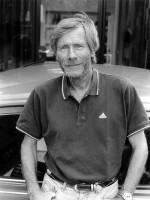Eugen Schuhmacher est un Réalisateur, Scénariste et Producteur Allemand né le 4 aout 1906 à Stuttgart (Allemagne)

Eugen Schuhmacher (actually Eugen Josef Robert Schuhmacher) (August 4, 1906 – January 8, 1973) was a German zoologist and pioneer of animal documentaries. Besides Bernhard Grzimek and Heinz Sielmann he belongs to the German wildlife documentary filmmakers with an international reputation.
He was awarded the Royal Geographical Society's Cherry Kearton Medal and Award in 1971.
Source : Wikidata
Eugen Schuhmacher

- Infos
- Photos
- Meilleurs films
- Famille
- Personnages
- Récompenses
Nom de naissance Eugen Josef Robert Schuhmacher
Nationalité Allemagne
Naissance 4 aout 1906 à Stuttgart (Allemagne)
Mort 8 janvier 1973 (à 66 ans) à Munich (Allemagne)
Nationalité Allemagne
Naissance 4 aout 1906 à Stuttgart (Allemagne)
Mort 8 janvier 1973 (à 66 ans) à Munich (Allemagne)
Biographie
Eugen Schuhmacher was born in Stuttgart, Germany. His career began in the early 1930s with educational and cultural shortfilms about the wildlife in South America and the German Reich. In the next four decades he made documentaries (feature length and shortfilms) about animals, the Inca culture, and the indigenous people from North America, South America and Papua New Guinea. This movies were awarded at festivals in Berlin, Venice and in Cannes. His movie Natur in Gefahr (Nature in Danger) from 1952 is an alerting report of the destruction of the nature paradises and the extinction of species. His feature film In the Shadow of the Karakoram (Im Schatten des Karakorum) received the German Film Prize for best documentary in 1955. In 1958 he discovered the German television for his work and he made one of the first German television series about endangered species. 37 episodes of On the Track of rare Animals (Auf den Spuren seltener Tiere) were shot, a series which has taken the audience on a journey to Galapagos, Papua New Guinea, Africa, and other exotic places. This series was very popular in German television. In 1966 he finished his movie project The Last Paradises: On the Track of Rare Animals, a film which had taken seven years to make. It was awarded at the Mountain Film Festival at Trento in 1967. Schuhmacher has died at age 66 of cancer in Munich, Germany. His last movie Europas Paradiese (Europe's paradises) had its premiere after his death.He was awarded the Royal Geographical Society's Cherry Kearton Medal and Award in 1971.
Le plus souvent avec
Filmographie de Eugen Schuhmacher (1 films)
Réalisateur

Die Letzten (1967)
, 1h56Réalisé par Eugen Schuhmacher
Genres Drame, Documentaire
Thèmes Mise en scène d'un animal, L'environnement, Documentaire sur la nature
Acteurs Carl Lange, Wolf Ackva, Alice Treff, Edith Schultze-Westrum, Horst Janson
Note74%





After an animated introduction about the history of extinct species (e.g. the quagga, the great auk and the dodo) it has gone to 60 countries and territories (including Turkey, Spain, Germany, Poland, Australia, Borneo, Chile, Spitzbergen, New Zealand, Papua New Guinea, India, Java, USA, and Peru) on all continents and to the most famous national parks. Species like the Hamilton's frog (Leiopelma hamiltoni) or the Javan rhinoceros were filmed for the very first time. Other sequences including footage of the kakapo, the takahe, the dancing of the red-crowned cranes, the fishing Kodiak bears, the whooping crane, the Asiatic lion, the Komodo dragon, the tuatara, the indri, and the birds of paradise. In particular the filming of the whooping cranes was the result of adventurous circumstances. Because the whooping crane was among the rarest birds in the world in the early 1960s there was no permission to entry the Aransas National Wildlife Refuge in Texas. Fortunately the cranes were provided with food by a plane and during that time the birds came to a wetland in the proximity of the fence. Schuhmacher and Barth planted themselves in a boat in a channel in front of the fence and were able to take some footage from a female and a chicken.
Scénariste

Die Letzten (1967)
, 1h56Réalisé par Eugen Schuhmacher
Genres Drame, Documentaire
Thèmes Mise en scène d'un animal, L'environnement, Documentaire sur la nature
Acteurs Carl Lange, Wolf Ackva, Alice Treff, Edith Schultze-Westrum, Horst Janson
Note74%





After an animated introduction about the history of extinct species (e.g. the quagga, the great auk and the dodo) it has gone to 60 countries and territories (including Turkey, Spain, Germany, Poland, Australia, Borneo, Chile, Spitzbergen, New Zealand, Papua New Guinea, India, Java, USA, and Peru) on all continents and to the most famous national parks. Species like the Hamilton's frog (Leiopelma hamiltoni) or the Javan rhinoceros were filmed for the very first time. Other sequences including footage of the kakapo, the takahe, the dancing of the red-crowned cranes, the fishing Kodiak bears, the whooping crane, the Asiatic lion, the Komodo dragon, the tuatara, the indri, and the birds of paradise. In particular the filming of the whooping cranes was the result of adventurous circumstances. Because the whooping crane was among the rarest birds in the world in the early 1960s there was no permission to entry the Aransas National Wildlife Refuge in Texas. Fortunately the cranes were provided with food by a plane and during that time the birds came to a wetland in the proximity of the fence. Schuhmacher and Barth planted themselves in a boat in a channel in front of the fence and were able to take some footage from a female and a chicken.
Producteur

Die Letzten (1967)
, 1h56Réalisé par Eugen Schuhmacher
Genres Drame, Documentaire
Thèmes Mise en scène d'un animal, L'environnement, Documentaire sur la nature
Acteurs Carl Lange, Wolf Ackva, Alice Treff, Edith Schultze-Westrum, Horst Janson
Rôle Producteur
Note74%





After an animated introduction about the history of extinct species (e.g. the quagga, the great auk and the dodo) it has gone to 60 countries and territories (including Turkey, Spain, Germany, Poland, Australia, Borneo, Chile, Spitzbergen, New Zealand, Papua New Guinea, India, Java, USA, and Peru) on all continents and to the most famous national parks. Species like the Hamilton's frog (Leiopelma hamiltoni) or the Javan rhinoceros were filmed for the very first time. Other sequences including footage of the kakapo, the takahe, the dancing of the red-crowned cranes, the fishing Kodiak bears, the whooping crane, the Asiatic lion, the Komodo dragon, the tuatara, the indri, and the birds of paradise. In particular the filming of the whooping cranes was the result of adventurous circumstances. Because the whooping crane was among the rarest birds in the world in the early 1960s there was no permission to entry the Aransas National Wildlife Refuge in Texas. Fortunately the cranes were provided with food by a plane and during that time the birds came to a wetland in the proximity of the fence. Schuhmacher and Barth planted themselves in a boat in a channel in front of the fence and were able to take some footage from a female and a chicken.
 Connexion
Connexion
